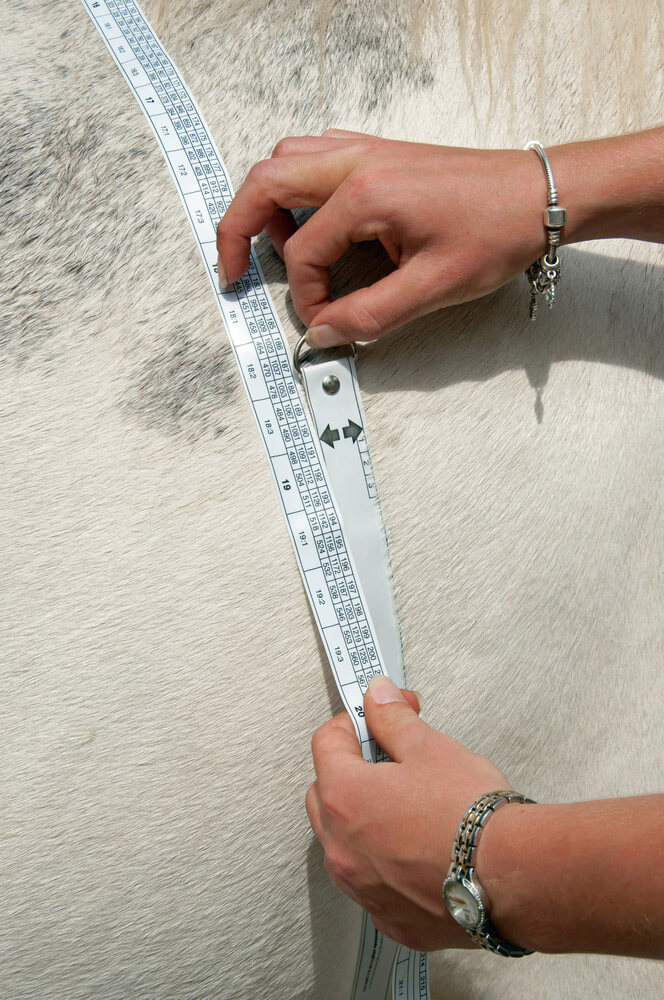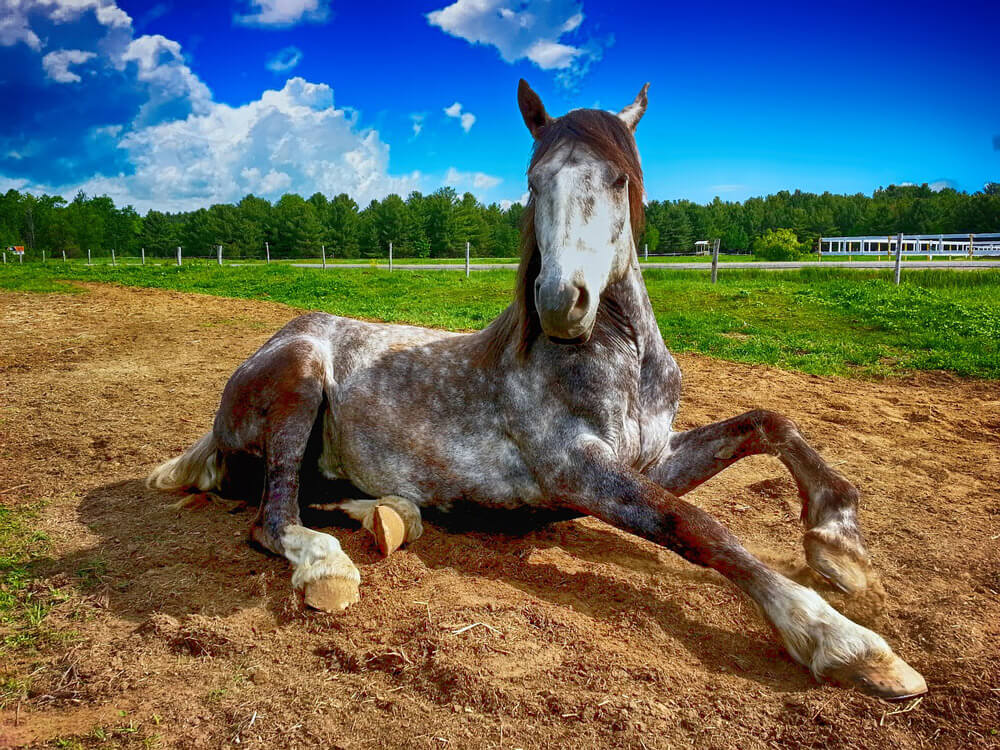As people have different body types, the same goes for horses, different horse breeds tend to gain various weight. Moreover, a horse’s weight is changing throughout his life due to lots of factors. But in fact, every horse breed has got their inherent weight range that is claimed as normal.
The average weight of an adult horse is about 1000 pounds (450 kg). While ponies generally weight about 600 pounds (270 kg) on average. And in comparison, donkeys usually tend to weight around 400 pounds (180 kg).
Actually, the weight of a horse is a crucial factor in terms of what purpose you’re looking for when choosing a horse. So let’s check what a typical weight is for common horse breeds. As for racing horses, they have to be well-trained, have great stamina as well as they are fed enough to stand the workload for long with no further health issues. Such horses tend to weight 1000+ pounds and this aspect is thoroughly controlled by equestrian experts.
Horse Weight Comparison Chart

- American Cream Draft Horse
- 1580-1990 pounds (720-900 kg)
- American Saddlebred
- 1000-1200 pounds (450-540 kg)
- Arabian Horse
- 800-1000 pounds (350-450 kg)
- Belgian Draft Horse
- 1850-2200 pounds (850-1000 kg)
- Friesian Horse
- 1300 pounds (590 kg)
- Gypsy Vanner
- 1000-1700 pounds (450-770 kg)
- Hackney
- 1000-1200 pounds (450-540 kg)
- Hungarian Warmblood
- 1300 pounds (600 kg)
- Irish Sport Horse
- 1200-1500 pounds (540-680 kg)
- Morgan Horse
- 900-1000 pounds (400-450 kg)
- Orlov Trotter
- 1000 pounds (450 kg)
- Paso Fino
- 700-1000 pounds (320-450 kg)
- Percheron
- 1850-2200 pounds (850-1000 kg)
- Shetland Pony
- 400-450 pounds (180-200 kg)
- Shire
- 1650-2750 pounds (750-1250 kg)
- Tennessee Walker
- 880-1400 pounds (400-650 kg)
- Thoroughbred Horse
- 1000 pounds (450 kg)
- Trakehner
- 1200-1500 pounds (550-700 kg)
- Walkaloosa
- 1000-1300 pounds (450-600 kg)
- Cleveland Bay Horse
- 1200-1500 pounds (550-680 kg)
As you can see, there is a huge weight range of different horse breeds. That’s why various horses are used in a diversity of activities such as riding, driving, foresting, farming, and many others. The same situation with ponies, which weight is less but also this aspect is different for various pony breeds. Now let’s take a look at the pony weight chart below.
Pony Weight Comparison Chart

- American Quarter Pony
- 800-900 pounds (360-400 kg)
- Connemara Pony
- 800-1000 pounds (360-450 kg)
- Hackney Pony
- 1000 pounds (450 kg)
- Haflinger Pony
- 800-1300 pounds (360-600 kg)
- Highland Pony
- 1200-1300 pounds (550-600 kg)
- Mountain Pony
- 400-700 pounds (180-320 kg)
- Pony of the Americas
- 1800-2200 pounds (820-1000 kg)
- Shetland Pony
- 300-600 pounds (140-270 kg)
- Welsh Cob
- 550-1000 pounds (250-450 kg)
- Welsh Pony
- 440-750 pounds (200-340 kg)
How to Weigh a Horse

Every horseman has to know what’s the weight of his horse to set the proper nutrition and health care. So you have to be aware of common methods to measure a horse’s weight. And we’ve got you covered! Just keep reading to check them all.
Weight Tape
One of the most popular methods is measuring a horse by a weight tape which gives quite precise results. This way fits best for horses who has got an average weight of 1000 pounds. If your horse is considered to be lighter, you should try other methods instead.
In addition, it’s highly recommended to take measurements on a regular basis, monthly tracking would be ideal. Moreover, it’s better to use the same tape each type to get more precise outcomes. When measure, double check the results so they are totally accurate.
Here’s a step-by-step guide on how to weigh a horse using a weight tape:
- Hold your horse still, before you start stepping to a horse to measure him, be sure that your companion is calm and he is tied to a hitching post.
- Start applying a tape by putting it over the horse’s back so it’s placed behind the withers. The tape should brace the horse where the girth is usually attached. Take the end of the tape and move it under the horse’s barrel behind the elbows.
- Hold the tape as snug as you do it when you measure your body – not too loose and not too tight. The horse has to stay calm and comfortable.
- Meet the end with a “zero” mark with the opposite end to see the result. The number which matches just the “zero” mark is the weight of your horse. And you’re done!

Horse Weight Calculator
Alternatively, you can measure a weight of your companion using a weight calculator. To apply this method, you’ll need two parameters instead of one that was mentioned before.
In fact, some sources claim that this method is deemed as more precise and you still need a weight tape. But the measuring process is a bit different.
- Hold your horse still, before you start stepping to a horse to measure him, be sure that your companion is calm and he is tied to a hitching post.
- Start applying a tape by putting it over the horse’s back so it’s placed behind the withers. The tape should brace the horse where the girth is usually attached. Take the end of the tape and move it under the horse’s barrel behind the elbows.
- Hold the tape as snug as you do it when you measure your body – not too loose and not too tight. The horse has to stay calm and comfortable.
- Meet the end with a “zero” mark with the opposite end to see the result. You’ve just measured the Heart Girth (HG).
- Then you have to measure the Body Length (BL) that goes along the body. This should be done by applying the tape from the point of the shoulder (below the horse’s neck) to the point of the buttock (the farthest point).
- Next you need to do some maths. There are several formulas that you can use to get the precise result depending on the age of a horse you have: weanling, yearling, adult, or pony.
Be attentive as the formulas below work for measurements being taken in inches and the weight obtained (WO) is resulted in pounds.
Weanling: HG inch x HG inch x BL inch / 280 = WO pounds.
Yearling: HG inch x HG inch x BL inch / 301 = WO pounds.
Adult: HG inch x HG inch x BL inch / 300 = WO pounds.
Pony: HG inch x HG inch x BL inch / 299 = WO pounds.
In addition, if you don’t want to do the math on your own, there are dozens of online calculators available, so you can just insert your measurements and get your horse’s weight in no time. Typically they have an option to choose the metric system which is more suitable for you.
The Heaviest Horses in the World

As there’s a huge array of horse breeds that are different in shapes, sizes and weights, you might wonder which horses are the biggest ones. We prepared the list of the heaviest horses in the world for your consideration.
- The Shire Horse
- 2,600 lbs
- Percheron
- 2,600 lbs
- The Suffolk Punch
- 2,200 lbs
- Clydesdale
- 2,000 lbs
- The Belgian Draft Horse
- 1,900 lbs
- The American Cream Horse
- 1,800 lbs
- Dutch Draft
- 1,600 lbs
- The Russian Heavy Draft Horse
- 1,500 lbs
- Gypsy Vanner
- 1,400 lbs
- Fjord
- 1,100 lbs
In addition, the largest horse ever existed was a Shire horse called Sampson. He was born in 1846 in Bedfordshire, England. He set the record by having a weigh of 3,360 pounds (1,524 kg). His height was 21.25 hands (7 feet).
Final Thoughts

Horsemen tend to take advantage of different horse breeds as they have better skills and conformation for specific purposes. That’s why people crossbreed some horses in order to get someone bigger, faster, durable.
Having a horse is extremely responsible as you have to take care of them regularly and be aware of how to track their health duly. Knowing your horse’s weight is an essential part of his well-being, as if your companion is overweight or underweight, that might lead to severe health issues. That’s why you have to know what’s the average weight of your horse breed and how to gain weight in a right way throughout his aging to prolong his longevity.
In terms of proper nutrition and feeding balance, you should weight your companion occasionally. There are several ways of doing it, we’ve covered the popular once that are easy to apply. With the help of a weight tape for horses, you’re able to take measurements of your companion quickly and get quite precise results.
Apart from weighing a horse, you should know some basics of horse aging. Check out our article on the common ways of determining the horse’s age. Stay healthy and wealthy!
